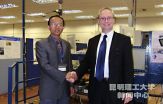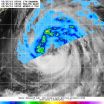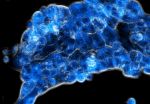(Press-News.org) In a paper published this week online in Global Society, researchers with University of California, San Diego School of Medicine and the Urban Studies and Planning Program, also at UC San Diego, present a bioregional guide that merges place-based (territorial) city planning and ecosystem management along the United States-Mexico border as way to improve human and environmental health.
Issues like climate change, economic crisis, natural disasters and disease outbreaks do not stop at national borders, compelling public health officials, academics and researchers to think differently about how to address wide-ranging human health challenges.
"City planners, health officials and researchers are combining knowledge and action in new ways to promote healthy placemaking," said Keith Pezzoli, PhD, UC San Diego Department of Communication and director of the Urban Studies and Planning Program. "Our health is not entirely hardwired genetically. It is also affected by environmental exposures, stress, diet, urban design and behavior. In our region, we can't think about health on just one side of the border because animals, sick people and pollutants move back and forth."
In border towns, health risks are common on both sides of the border. In the paper, Pezzoli, with co-authors Wael K. Al-Delaimy, MD, PhD, professor and chief of the Division of Global Health in the UC San Diego Department of Family and Preventive Medicine, and Catherine Wood Larsen, staff research associate in the Department of Family and Preventive Medicine, recommend supporting ecological restoration in transborder metropolitan areas where urban sprawl is taking place, such as in the canyon communities of Tijuana, Baja California.
In a related paper, published in the International Journal of Environmental Research and Public Health on Sept. 15, Pezzoli, Al-Delaimy and Larsen looked at the impact of the environment on residents of Tijuana's rapidly urbanizing settlement called Los Laureles Canyon. This was the first large scale investigation evaluating the health of this population.
In one decade, the area grew from zero residents to 70,000, forming multiple communities called "colonias." These settlements do not typically comply with standard building codes and are without basic infrastructure, such as a sewer system, trash collection or paved roads. Many unregulated dumpsites dot the area, often containing a variety of hazardous waste from industry, construction and household garbage.
With Alter Terra (a binational non-governmental organization), the UC San Diego Superfund Research Center, the Center for U.S.-Mexican Studies and the Universidad Autonoma de Baja California, researchers interviewed residents of Los Laureles Canyon about their well-being and any symptoms of illness. The occupants of the 4.6-square-mile area, a sub-basin of the bi-national Tijuana River Basin, reported skin problems, stomach discomforts, eye irritation, confusion/difficulty concentrating and extreme fatigue, which are symptoms commonly associated with exposure to environmental toxins.
"We have people who are living in dismal situations surrounded by dump sites," said Al-Delaimy, who was the principal investigator on the study. "Their houses are made of garage doors brought from the U.S. and other materials that are mismatched. This is an environmental injustice that is impacting their health and has consequences for the San Diego region as well."
For example, the ecological health of the Tijuana River Estuary in San Diego County depends upon what happens in the Tijuana River Basin. Toxins in upstream soils can contaminate rain runoff from Los Laureles Canyon, which eventually drains north to the U.S. and into the Pacific Ocean.
"We are joined together to Mexico through the watershed," said Pezzoli. "We are in it together because of land, buildings and streets, but also from a health perspective because disease doesn't stop at the border. The failure of control measures in one country has the potential to put neighboring communities at risk."
To achieve an interconnected healthy bioregion, the scientists said public health professionals need training in global health diplomacy and cooperation. In addition, universities, through programs like the UC San Diego Superfund Research Center, must integrate community engagement and basic research translation through a cross-border approach. Creating sustainable and resilient communities, even across national borders, is possible by fostering investment in natural resources, rooted livelihoods and institutions, they said.
INFORMATION:
Co-authors for the Global Society paper include Justine Kozo, County of San Diego Office of Border Health, Health and Human Services Agency; Karen Ferran, Early Warning Infectious Disease Surveillance Program, California Department of Public Health; Wilma Wooten, Public Health Services for the County of San Diego Health and Human Services Agency; and Gudelia Rangel Gomez, US-Mexico Border Health Commission, Mexico Section.
Co-authors for the International Journal of Environmental Research and Public Health paper include Wael K. Al-Delaimy, UC San Diego Department of Family and Preventive Medicine, Division of Global Health, Keith Pezzoli, UC San Diego Department of Communication and Urban Studies and Planning Program, and Catherine Wood Larsen, UC San Diego Department of Family and Preventive Medicine.
Funding support for both studies came, in part, from the National Institute of Environmental Health Sciences of the National Institutes of Health (grant P42ES010337).
Disease without borders
Bioregional approach to healthy living involves health care, city planning and ecological restoration
2014-09-26
ELSE PRESS RELEASES FROM THIS DATE:
Cardiology leaders call for global prevention of heart disease, stroke
2014-09-26
WASHINGTON (Sept. 29, 2014) — Heart disease and stroke contribute to 30 percent of global deaths, more than all infectious and parasitic diseases combined, and 11 cardiovascular organizations are calling for the United Nations to address prevention of heart disease and other non-communicable diseases.
In a statement published in the Journal of the American College of Cardiology and other cardiology journals, the World Heart Federation's Global Cardiovascular Disease Taskforce—which is comprised of cardiologists and health advocates from the World Heart Federation, African ...
Progress in materials science
2014-09-26
RESEARCHERS at the University of Huddersfield have collaborated with a colleague at a leading Chinese university to produce a detailed appraisal of a complex new welding technique that could be increasingly valuable to modern industry.
Professor Andrew Ball (pictured below) and his colleague Dr Fengshou Gu, of the University of Huddersfield's Centre for Efficiency and Performance Engineering, teamed up with Professor Xiaocong He of Kunming University of Science and Technology's (KUST) Innovative Manufacturing Research Centre in order to investigate the technique ...
Severe periodontitis: Sixth most prevalent health condition in the world
2014-09-26
Alexandria, Va., USA – The International and American Associations for Dental Research (IADR/AADR) have published a paper titled "Global Burden of Periodontitis: A Systematic Review and Meta-Regression." The manuscript, by lead researcher Wagner Marcenes (Queen Mary University of London, Institute of Dentistry, Barts and The London School) is published in the OnlineFirst portion of the IADR/AADR Journal of Dental Research (JDR).
The purpose of this study was to consolidate all epidemiological data about severe periodontitis and subsequently to generate internally consistent ...
Morphed images of Hollywood celebrities reveal how neurons make up your mind
2014-09-26
An international team of scientists, involving Professor Rodrigo Quian Quiroga, director of the Centre for Systems Neuroscience and Head of Bioengineering at the University of Leicester, has shown how individual neurons in the human brain react to ambiguous morphed faces.
For this, the researchers used images of celebrities, such as Angelina Jolie and Halle Berry, morphed together to create an ambiguous face which test subjects were asked to identify.
The study found that for the same ambiguous images, the neurons fired according to the subjective perception by the ...
NASA sees Tropical Storm Kammuri's spiral bands of soaking thunderstorms
2014-09-26
Tropical Storm Kammuri continues to strengthen on its north-northwestern track through the Northwestern Pacific Ocean and NASA's TRMM satellite identified a band of thunderstorms containing heavy rainfall northwest of the storm's center. Meanwhile NASA's Aqua satellite got a look at the entire storm and saw that those bands of storms circled the entire storm.
The Tropical Rainfall Measuring Mission or TRMM satellite flew over the northern half of Tropical Storm Kammuri on Sept. 26 at 1:44 a.m. EDT and the Precipitation Radar instrument saw a strong band of thunderstorms ...
UB study: COPD patients breathe easier with Lung Flute
2014-09-26
BUFFALO, N.Y. – Patients with chronic obstructive pulmonary disease (COPD) report improved symptoms and health status when they use a hand-held respiratory device called the Lung Flute®, according to a new study by the University at Buffalo. Usually caused by smoking, COPD, which includes chronic bronchitis and emphysema, is the third leading cause of death in the U.S.
The Lung Flute, manufactured by Medical Acoustics, (Buffalo), uses sound waves to break up mucus in the lungs. The device allows patients to clear lung mucus simply by blowing into the hand-held respiratory ...
Penn chemists observe key reaction for producing 'atmosphere's detergent'
2014-09-26
VIDEO:
Earth's atmosphere is a complicated dance of molecules. The chemical output of plants, animals and human industry rise into the air and pair off in sequences of chemical reactions. Such...
Click here for more information.
Earth's atmosphere is a complicated dance of molecules. The chemical output of plants, animals and human industry rise into the air and pair off in sequences of chemical reactions. Such processes help maintain the atmosphere's chemical balance; for ...
National Geographic/GlobeScan study reveals increased concern about environment
2014-09-26
WASHINGTON (Sept. 26, 2014)—A new global analysis released today by the National Geographic Society and GlobeScan finds that concern about environmental problems has increased in most countries surveyed, and that more people now expect global warming will negatively affect them during their lifetime than in 2012. Despite this, National Geographic's Greendex, a comprehensive measure of consumer behavior in 65 areas related to housing, transportation, food and consumer goods, shows that sustainable consumer behavior has only grown slowly.
Results of the 2014 Greendex, a ...
Strategy to reduce side effects in modern cancer therapy
2014-09-26
This news release is available in German. An interdisciplinary team of researchers from the University of Vienna (Institute of Inorganic Chemistry) and the Medical University of Vienna (Institute for Cancer Research) has successfully developed a new strategy for reducing the often serious side effects of an important class of modern anticancer drugs (tyrosine kinase inhibitors). The novel drug is supposed to restrict its activity with high selectivity to the malignant tumour.
The occurrence of severe side effects and the development of resistance are two of the biggest ...
Sensitive youngsters
2014-09-26
Young individuals of a species are often more sensitive towards environmental stress than their adult counterparts. Scientists from GEOMAR Helmholtz Centre for Ocean Research Kiel now observed this effect in the sea star Asterias rubens from the Baltic Sea. In a long-term laboratory experiment that was conducted in the framework of the German research network BIOACID (Biological Impacts of Ocean Acidification), the researchers simulated three different levels of acidification that could be reached in the Baltic Sea by the uptake of additional carbon dioxide (CO2) within ...
LAST 30 PRESS RELEASES:
Making lighter work of calculating fluid and heat flow
Normalizing blood sugar can halve heart attack risk
Lowering blood sugar cuts heart attack risk in people with prediabetes
Study links genetic variants to risk of blinding eye disease in premature infants
Non-opioid ‘pain sponge’ therapy halts cartilage degeneration and relieves chronic pain
AI can pick up cultural values by mimicking how kids learn
China’s ecological redlines offer fast track to 30 x 30 global conservation goal
Invisible indoor threats: emerging household contaminants and their growing risks to human health
Adding antibody treatment to chemo boosts outcomes for children with rare cancer
Germline pathogenic variants among women without a history of breast cancer
Tanning beds triple melanoma risk, potentially causing broad DNA damage
Unique bond identified as key to viral infection speed
Indoor tanning makes youthful skin much older on a genetic level
Mouse model sheds new light on the causes and potential solutions to human GI problems linked to muscular dystrophy
The Journal of Nuclear Medicine ahead-of-print tip sheet: December 12, 2025
Smarter tools for peering into the microscopic world
Applications open for funding to conduct research in the Kinsey Institute archives
Global measure underestimates the severity of food insecurity
Child survivors of critical illness are missing out on timely follow up care
Risk-based vs annual breast cancer screening / the WISDOM randomized clinical trial
University of Toronto launches Electric Vehicle Innovation Ontario to accelerate advanced EV technologies and build Canada’s innovation advantage
Early relapse predicts poor outcomes in aggressive blood cancer
American College of Lifestyle Medicine applauds two CMS models aligned with lifestyle medicine practice and reimbursement
Clinical trial finds cannabis use not a barrier to quitting nicotine vaping
Supplemental nutrition assistance program policies and food insecurity
Switching immune cells to “night mode” could limit damage after a heart attack, study suggests
URI-based Global RIghts Project report spotlights continued troubling trends in worldwide inhumane treatment
Neutrophils are less aggressive at night, explaining why nighttime heart attacks cause less damage than daytime events
Menopausal hormone therapy may not pose breast cancer risk for women with BRCA mutations
Mobile health tool may improve quality of life for adolescent and young adult breast cancer survivors
[Press-News.org] Disease without bordersBioregional approach to healthy living involves health care, city planning and ecological restoration






